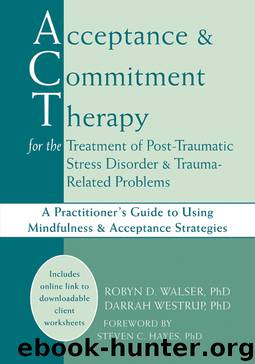Acceptance and Commitment Therapy for the Treatment of Post-Traumatic Stress Disorder and Trauma-Related Problems by Robyn Walser

Author:Robyn Walser [Walser, Robyn D., and Westrup, Darrah]
Language: eng
Format: epub, mobi
ISBN: 9781608826469
Publisher: New Harbinger Publications
Published: 2007-05-31T16:00:00+00:00
Cargo Space
The box-with-stuff-in-it metaphor (Hayes et al., 1999) graphically demonstrates how private events—thoughts, feelings, and physical sensations—constitute content that is contained or experienced by the self. When doing this exercise, we typically grab a box of tissues and a wastebasket and put both in front of the client (or, when in a group setting, in the middle of the group circle). We then conduct the following exercise, being sure to relate the metaphor to the client’s trauma history:
Therapist: Let’s say for a moment, that you are this wastebasket.
Client: (laughs derisively) That fits.
Therapist: Yes, let’s agree that you’ve had some bad things happen to you. (Takes a couple of pieces of tissue, crumples them up, and tosses them into the basket. The tissues represent ongoing experience like thoughts, emotions, etc.) What else comes up for you when something reminds you about your trauma?
Client: I get really anxious. I start sweating. (Therapist wads up a couple of pieces of tissue and throws them in the basket.)
Therapist: What comes up next?
Client: I start thinking I’m going to lose control. (Therapist wads up a tissue and tosses it in.)
Therapist: Then what?
Client: I try to distract myself. Sometimes I go shopping or I drink. (Therapist crumples up several tissues and throws them in.)
Therapist: What comes up with that?
Client: Shame—I hate myself. (Therapist throws in a couple of tissues.)
We typically engage in this exercise for a while as a way to emphasize the point and to create a big pile of tissues in the basket.
Therapist: (throwing a final tissue in) Isn’t this interesting? All these pieces (stirs around the tissues) have to do with the first one. Instead of getting less important, the initial thought about the trauma got more important. The more you try to get rid of it, the bigger it gets! Even if we cover it up, it’s still there, and since you’re the basket, you know it’s there. And if you are really determined not to have it, your life can become about covering it up, trying to squish it down, hide it away. (pause) But what if it’s the case that you just hold these events? … Notice that the tissues are not the basket, they are just something the basket holds.
Anything the client says at this point is another tissue to be added to the basket. It is helpful to remind clients that history is additive, not subtractive. That is, history is unidirectional; we can only have more experience—even trying to remove a tissue is more experience.
This metaphor effectively demonstrates (a) that thoughts and feelings are content held within the self, (b) that control efforts are not only ineffective but add to the problem, and (c) that there is a cost to spending one’s effort and energy on attempts to make unwanted thoughts and feelings go away.
Download
Acceptance and Commitment Therapy for the Treatment of Post-Traumatic Stress Disorder and Trauma-Related Problems by Robyn Walser.mobi
This site does not store any files on its server. We only index and link to content provided by other sites. Please contact the content providers to delete copyright contents if any and email us, we'll remove relevant links or contents immediately.
The Art of Thinking Clearly by Rolf Dobelli(10213)
The 5 Love Languages: The Secret to Love That Lasts by Gary Chapman(9587)
Mindhunter: Inside the FBI's Elite Serial Crime Unit by John E. Douglas & Mark Olshaker(9186)
Becoming Supernatural by Dr. Joe Dispenza(8119)
Nudge - Improving Decisions about Health, Wealth, and Happiness by Thaler Sunstein(7615)
The Road Less Traveled by M. Scott Peck(7522)
Enlightenment Now: The Case for Reason, Science, Humanism, and Progress by Steven Pinker(7228)
Mastermind: How to Think Like Sherlock Holmes by Maria Konnikova(7223)
Win Bigly by Scott Adams(7094)
The Way of Zen by Alan W. Watts(6504)
Factfulness: Ten Reasons We're Wrong About the World – and Why Things Are Better Than You Think by Hans Rosling(4691)
The State of Affairs by Esther Perel(4634)
Gerald's Game by Stephen King(4571)
Man's Search for Meaning by Viktor Frankl(4420)
The Confidence Code by Katty Kay(4187)
Thinking in Bets by Annie Duke(4152)
The Healing Self by Deepak Chopra(3473)
Hidden Persuasion: 33 psychological influence techniques in advertising by Marc Andrews & Matthijs van Leeuwen & Rick van Baaren(3472)
The Worm at the Core by Sheldon Solomon(3432)
